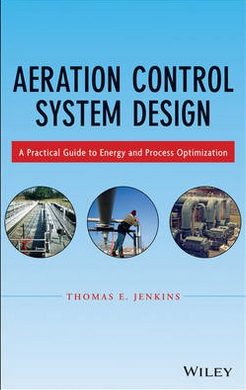
Aeration Control System Design: A Practical Guide to Energy and Process Optimization
[Book Description]
Taking an integrated, cross-disciplinary approach to this critical process, Aeration Control System Design comprehensively addresses the concept and system design of aeration activated wastewater treatment. Author Thomas E. Jenkins, a veteran in the field, covers complete treatment of aeration system controls, processes, and instrumentation and includes a theoretical and mathematical treatment of case histories, complete with design procedures and analysis methodology. Equations, charts, figures, and diagrams are used extensively throughout, making this a vital resource for civil/environmental engineers, mechanical engineers, and electrical/instrumentation engineers.
[Table of Contents]
Preface xi
Acknowledgments xiii
List of Figures xv
List of Tables xxi
1 Introduction 1 (20)
1.1 Basic Concepts and Objectives 2 (7)
1.2 Safety 9 (1)
1.3 The Importance of an Integrated Approach 10 (3)
1.4 Importance of Operator Involvement 13 (1)
1.5 The Benefits of Successful Aeration 14 (5)
Process Automation
1.5.1 Energy Cost Reduction 14 (4)
1.5.2 Treatment Performance 18 (1)
1.5.3 Improved Equipment Life 18 (1)
Example Problems 19 (2)
2 Initial System Assessment 21 (28)
2.1 Define Current Operations 24 (13)
2.1.1 Energy Cost 25 (4)
2.1.2 Energy Consumption Patterns 29 (6)
2.1.3 Influent and Effluent Process 35 (1)
Parameters
2.1.4 Treatment Performance 36 (1)
2.2 Evaluate Process and Equipment 37 (3)
2.3 Benchmark Performance 40 (2)
2.4 Estimate Potential Energy Savings and 42 (3)
Performance Improvement
2.5 Prepare Report 45 (2)
Example Problems 47 (2)
3 Aeration Processes 49 (28)
3.1 Process Fundamentals 49 (19)
3.1.1 Peripheral Equipment and Processes 55 (7)
3.1.2 BOD Removal 62 (4)
3.1.3 Nitrification 66 (1)
3.1.4 Denitrification 67 (1)
3.2 Loading Variations and Their Implications 68 (2)
3.3 Process Limitations and Their Impact on 70 (4)
Control Systems
Example Problems 74 (3)
4 Mechanical and Diffused Aeration Systems 77 (36)
4.1 Oxygen Transfer Basics 78 (9)
4.2 Types of Aerators 87 (19)
4.2.1 Mechanical Aerators 88 (2)
4.2.2 Mechanical Aeration Control Techniques 90 (5)
4.2.3 Diffused Aeration 95 (8)
4.2.4 Diffused Aeration Control Techniques 103 (3)
4.3 Savings Determinations 106 (5)
Example Problems 111 (2)
5 Blowers and Blower Control 113 (48)
5.1 Common Application and Selection Concerns 114 (20)
5.1.1 Properties of Air 114 (5)
5.1.2 Effect of Humidity 119 (4)
5.1.3 Pressure Effects 123 (2)
5.1.4 Common Performance Characteristics 125 (9)
5.2 Positive Displacement Blowers and Control 134 (9)
Characteristics
5.2.1 Types and Characteristics 134 (1)
5.2.2 Lobe Type PD Blowers 134 (4)
5.2.3 Screw Blowers 138 (3)
5.2.4 Control and Equipment Protection 141 (2)
Considerations
5.3 Dynamic Blowers 143 (14)
5.3.1 Types and Characteristics 144 (6)
5.3.2 Multistage Centrifugal Blowers 150 (2)
5.3.3 Geared Single Stage Centrifugal 152 (2)
Blowers
5.3.4 Turbo Blowers 154 (1)
5.3.5 Control and Protection Considerations 155 (2)
Example Problems 157 (4)
6 Piping Systems 161 (30)
6.1 Design Considerations 162 (16)
6.1.1 Layout 162 (10)
6.1.2 Pipe Size 172 (2)
6.1.3 Pipe Material 174 (4)
6.2 Pressure Drop 178 (4)
6.3 Control Valve Selection 182 (5)
Example Problems 187 (4)
7 Instrumentation 191 (42)
7.1 Common Characteristics and Electrical 192 (10)
Design Considerations
7.2 Pressure 202 (3)
7.3 Temperature 205 (4)
7.4 Flow 209 (7)
7.5 Analytic Instruments 216 (8)
7.5.1 Dissolved Oxygen 217 (4)
7.5.2 Offgas Analysis 221 (3)
7.5.3 pH and ORP 224 (1)
7.6 Motor Monitoring and Electrical 224 (2)
Measurements
7.7 Miscellaneous 226 (4)
Example Problems 230 (3)
8 Final Control Elements 233 (28)
8.1 Valve Operators 234 (4)
8.2 Guide Vanes 238 (1)
8.3 Motor Basics 239 (8)
8.4 Motor Control 247 (4)
8.5 Variable Frequency Drives 251 (8)
Example Problems 259 (2)
9 Control Loops and Algorithms 261 (48)
9.1 Control Fundamentals 264 (16)
9.1.1 Discrete Controls 264 (3)
9.1.2 Analog Control 267 (4)
9.1.3 Proportional-Integral-Derivative 271 (3)
9.1.4 Deadband Controllers 274 (2)
9.1.5 Floating Control 276 (4)
9.2 Dissolved Oxygen Control 280 (7)
9.3 Aeration Basin Air Flow Control 287 (1)
9.4 Pressure Control 288 (3)
9.5 Most-Open-Valve Control 291 (2)
9.6 Blower Control and Coordination 293 (9)
9.7 Control Loop Timing Considerations 302 (1)
9.8 Miscellaneous Controls 303 (2)
Example Problems 305 (4)
10 Control Components 309 (24)
10.1 Programmable Logic Controllers 310 (13)
10.1.1 System Architecture 314 (1)
10.1.2 Program Structure 315 (3)
10.1.3 Communications Networks 318 (4)
10.1.4 Accommodating Instrument Inaccuracy 322 (1)
and Failure
10.2 Distributed Control Systems 323 (1)
10.3 Human Machine Interfaces 323 (5)
10.3.1 Supervisory Control and Data 325 (2)
Acquisition
10.3.2 Touchscreens 327 (1)
10.4 Control Panel Design Considerations 328 (2)
Example Problems 330 (3)
11 Documentation 333 (18)
11.1 Specification Considerations 335 (3)
11.2 Data Lists 338 (3)
11.3 Process and Instrumentation Diagrams 341 (1)
11.4 Ladder and Loop Diagrams 342 (2)
11.5 One-Line Diagrams 344 (1)
11.6 Installation Drawings 345 (2)
11.7 Loop Descriptions 347 (1)
11.8 Operation and Maintenance Manuals 348 (1)
Example Problems 349 (2)
12 Commissioning 351 (20)
12.1 Inspection 354 (3)
12.2 Testing 357 (4)
12.3 Tuning 361 (4)
12.4 Training 365 (3)
12.5 Measurement and Verification of Results 368 (1)
Example Problems 369 (2)
13 Summary 371 (6)
13.1 Review of Integrated Design Procedure 371 (3)
13.2 Potential Problem Areas 374 (1)
13.3 Benefits 375 (1)
Example Problems 375 (2)
Appendix A: Example Problem Solutions 377 (70)
Appendix B: List of Equations and Variables 447 (38)
Bibliography 485 (2)
Index 487

 新书报道
新书报道